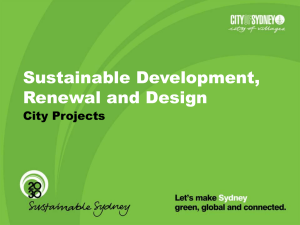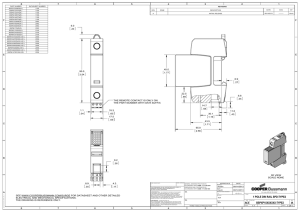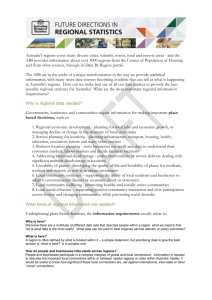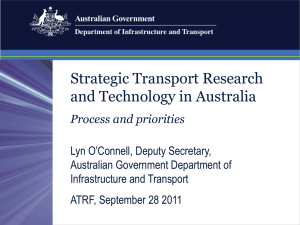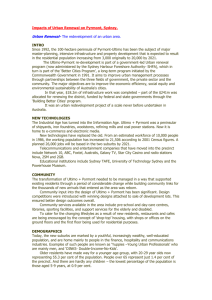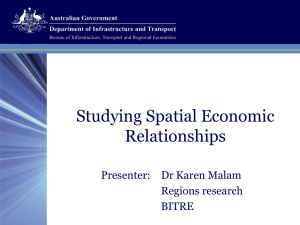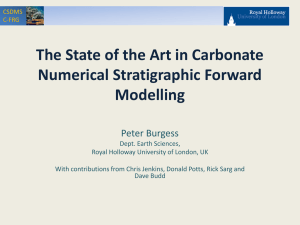Ms Dorte Ekelund - National Statistical Service
advertisement
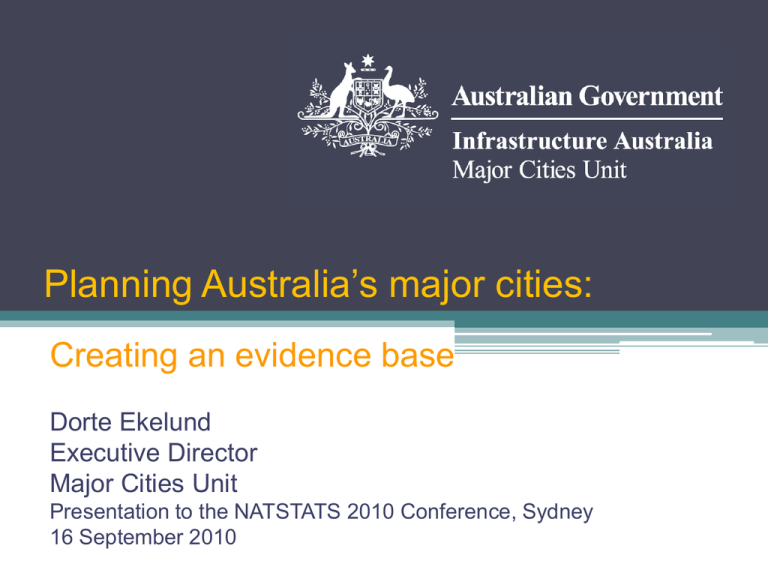
Planning Australia’s major cities: Creating an evidence base Dorte Ekelund Executive Director Major Cities Unit Presentation to the NATSTATS 2010 Conference, Sydney 16 September 2010 Outline Federal Government involvement in cities - State of Australian Cities 2010 - National urban policy What do we need to know? - Defining urban - Indicators for effective urban policy and planning What are we measuring? - Reliability and consistency - Causal versus correlated data Transforming our Cities 1950s - Housing 1970s - Services 1990s - Regeneration 2007 + - Infrastructure Australia - Major Cities Unit - COAG Reform Pyrmont Bridge 2006 National planning criteria for cities A national objective for cities that they are: - Globally competitive Productive Sustainable Liveable Socially inclusive National criteria for strategic planning systems - State governments to meet criteria by 2012 - Linked to federal infrastructure funding Developing national urban policy Phase 1 • Gather the evidence • State of Australian Cities 2010 Phase 2 • Prepare options • A strategy for Australian Cities State of Australian Cities 2010 A national snapshot of Australia’s cities An evidence base to: - generate debate - present challenges - highlight trends - measure progress - develop policy http://www/infrastructure.gov.au/mcu Defining ‘urban’ - What is a city? Australia: an ‘urban’ nation 75 % population live in 17 major cities over 100,000 82% in cities over 30,000 Cities 30,000 50,000 2% Rest of Australia 18% 2 Cities > 3 million 39% of total population Cities 50,000 100,000 5% Cities 100,000250,000 6% Cities 250,000 1 million 8% 3 Cities 1-3 million 22% Where are city boundaries? Spatial aggregation - Statistical v Local Government v Metropolitan v Conurbation - Cities within cities - Expanding urban boundaries - Peri-urban areas Policy implications - Tracking change over time - Scale - Density - ‘Per capita’ indicators City indicators Themes - Productivity - Sustainability - Liveability What do we need to know? - Where are we now? - Where are we going? What are we measuring? - Gaps Overlaps Interrelationships Causes or correlations Interpreting the data Population growth 2056 2056 Sydney Melbourne Brisbane Perth Adelaide Hobart Darwin Canberra 2026 2026 2056 2006 2056 2006 2026 2026 2056 2006 2026 2006 2006 2056 2056 2006 2006 2056 2006 Source: Australian Bureau of Statistics (2009) Population Projections 2006-2100. ABS cat 3220.0 What are we measuring? Population projections Multiple projections - ABS v Treasury IGR 3 v States v Agencies (eg. Health) Policy sensitive projections - Components of growth - Projected v Planned v Targets - eg. Fertility v Immigration v Labour force Spatial projections - Combining location and nature of growth Productivity Economic importance of cities 76% of employment 80% of economic activity (GDP) 84% of economic growth (2003-2008) Gateways to the global economy What are we measuring? Contribution of cities to productivity Isolating factors in the city system - Eg. Urban congestion Perth Brisbane Sydney Dangers of extrapolating state data to cities - Eg. Queensland Melbourne Identifying contribution of Adelaide cities to regional economic activity Eg. mining and agriculture (research, distribution, administration, finance) SOAC 2010 p. 18 0 60 100 GDP per Capita ($US ‘000) Sustainability Total Greenhouse Contribution of Australian Transport 250000 International shipping Gg (total CO2 equivalent emissions) 200000 International aviation Emissions for international transport, to and from Australia, are estimated using half of total fuel use. Domestic marine 150000 Domestic aviation Rail 100000 Road Base case projections 50000 0 1945 1950 1955 1960 1965 1970 1975 1980 1985 1990 1995 2000 2005 2010 2015 2020 2025 2030 Note: total warming effects - includes both directly radiative gases and indirectly radiative gases. Sources: BTRE (2006), BITRE (2009), BITRE estimates What are we measuring? Recent trends in car use Measures of progress Source: Stanley, J. 2010 Moving People Liveability Housing diversity 3.4 3.2 Bedrooms per dwelling WA QLD NSW VIC 3.0 SA Houses are getting bigger... 2.8 NSW QLD VIC WA SA 2.6 2.4 Persons per household 2005–06 2003–04 2002–03 2000–01 1999–00 1997–98 1996–97 1995–96 1994–95 2.2 Year Source: BITRE analysis of ABS 2007 Cat. No. 4130.0.55.001 but households are getting smaller! What are we measuring? Community wellbeing indicators Need for indicators Accessibility Natural landscapes Quality open space Safety Legibility What’s important to whom? Real Perceived Quality Quantity Interpreting the data Indices City indices Issue- specific indices SEIFA VAMPIRE Social inclusion Resources + Participation - Choice - Opportunity - Capability Brisbane 2006 Dodson and Sipe (2008) Unsettling the suburbs. Urban Research Program, Griffith University Conclusion Limitations - Data gaps - especially about the contribution of cities to productivity, sustainability, liveability - Lack of comparability - Different scales - Different methodologies - Different purposes Conclusion Need a suite of indicators - Consistent geographies - Consistent time series data - More open data sources - Measures of progress not just of problems - Separating causes from correlations - Better appreciation of interrelationships between built environment and economic, social and environmental outcomes - Considering alternative futures Complex systems “If you think you know all about a city, it’s probably just a town.” Peter Carey, 30 Days in Sydney. Pyrmont Bridge c1900 Dynamic systems Thank you Pyrmont Bridge 2006
